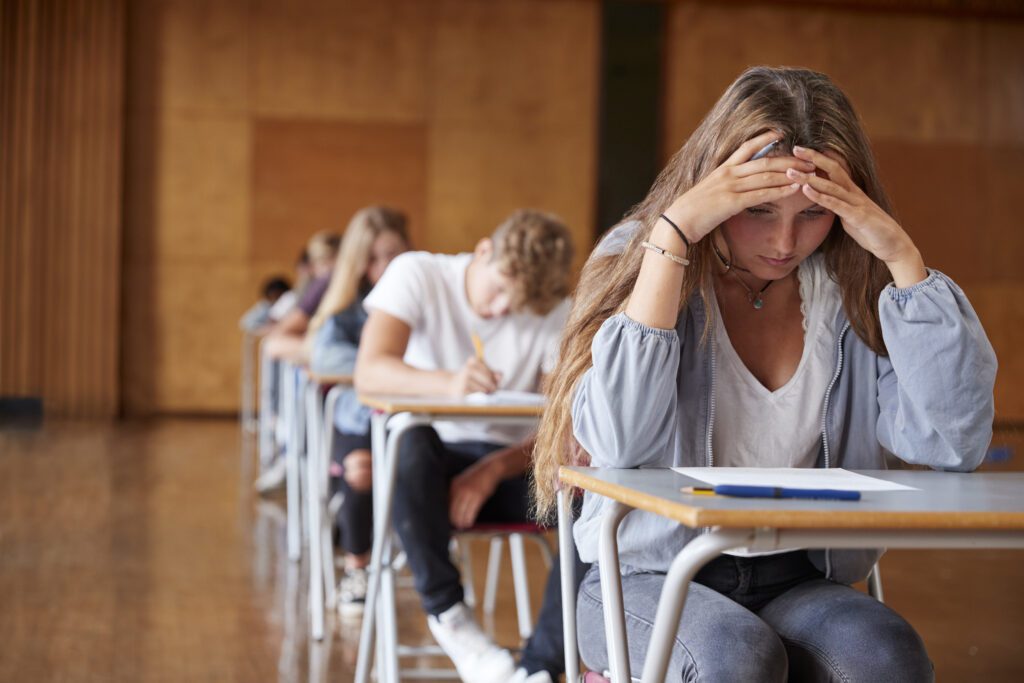
How Does Anxiety Affect Kids in School?
How Does Anxiety Affect Kids in School? – Mindbliss Hospital
In today’s fast-paced and competitive world, children and teenagers are experiencing increasing levels of anxiety, especially in school environments. While a certain amount of stress is considered normal, persistent and overwhelming anxiety can have serious consequences on a student’s academic performance, emotional well-being, and social development.
Many parents and teachers may mistake anxiety for laziness or disobedience, which further complicates the issue. Recognizing how anxiety manifests and affects students is essential for early intervention. At Mindbliss Hospital, we’ve seen how untreated anxiety in childhood can escalate into long-term mental health challenges like depression, substance abuse, or panic disorders.
This blog aims to spread awareness about how anxiety affect kids in school and provides insights into its causes, symptoms, and best treatment options. Whether you’re a parent, educator, or caregiver, this guide will help you better support anxious children and teens.
What is Anxiety in Children and Students?
Anxiety is a natural and often helpful emotional response to situations involving stress, fear, or uncertainty. It serves as a protective mechanism, preparing the body and mind to face potential challenges or threats. However, when this emotional reaction becomes overwhelming, constant, or disproportionate to the actual situation, it may develop into an anxiety disorder — a serious mental health condition that can significantly impact daily functioning.

In children and students, anxiety can manifest quite differently than it does in adults, making it harder to recognize and address. Younger children may not have the verbal skills to express their feelings clearly and might instead show physical symptoms such as frequent stomachaches, headaches, or a general sense of unease. They may appear unusually clingy, seek constant reassurance, or have difficulty separating from their parents or caregivers. On the other hand, adolescents and teenagers may exhibit symptoms such as increased irritability, mood swings, withdrawal from friends and family, difficulty concentrating in school, or complete avoidance of certain activities, social situations, or academic tasks.
Understanding that anxiety in young people is not merely a phase or a sign of weakness is crucial. When left unaddressed, it can interfere with their academic performance, relationships, self-esteem, and overall well-being. Early recognition, compassionate support, and appropriate intervention are key to helping children and students manage their anxiety effectively and lead emotionally healthy lives.
Common Symptoms of Anxiety in Students
Anxiety in students can manifest in various physical, emotional, and behavioral ways, often affecting their performance at school, relationships with peers, and overall mental well-being. Unlike occasional nervousness that everyone experiences from time to time, chronic anxiety in students is persistent and can significantly disrupt their ability to function in daily academic and social settings.
Some of the most common symptoms of anxiety in students include:
- Constant Worry or Fear: Students may experience ongoing and excessive worry about schoolwork, exams, social interactions, or even minor everyday matters. This worry often seems irrational or out of proportion but is very real to them and difficult to control.
- Avoidance Behaviors: Many students with anxiety try to cope by avoiding the source of their stress. This might involve frequently skipping school, avoiding certain classes, staying away from group activities, or making excuses to miss exams or presentations.
- Difficulty Concentrating: Anxiety can interfere with cognitive functions like attention and memory. As a result, students may struggle to focus during lessons, follow instructions, or complete assignments on time, despite having the intellectual ability to do so.
- Sleep Disturbances: Anxious students often find it hard to relax and fall asleep. They may suffer from insomnia, restless sleep, or frequent nightmares, which can leave them feeling tired, unfocused, and emotionally drained throughout the day.
- Physical Symptoms: Anxiety often presents with physical complaints, especially in younger students who may not be able to articulate their emotional state. Common symptoms include frequent headaches, nausea, stomachaches, dizziness, muscle tension, and general fatigue.
- Emotional Outbursts: When the stress becomes overwhelming, students may experience emotional breakdowns over seemingly minor issues. This could appear as sudden crying, irritability, panic attacks, or extreme sensitivity to criticism or change in routine.
It is essential to recognize that these symptoms are not simply acts of defiance, laziness, or attention-seeking. Anxiety is a legitimate and diagnosable mental health condition. With timely intervention, understanding, and support from parents, teachers, and mental health professionals, students can learn to manage their anxiety effectively. Early identification and compassionate responses can make a significant difference in their emotional resilience, academic success, and overall development.
Causes of School Anxiety
School-related anxiety is a complex emotional challenge that often arises from a combination of academic, social, personal, and family-related stressors. Unlike temporary nervousness or stress, school anxiety can persist and interfere with a student’s daily routine, academic performance, and overall emotional health. Understanding the root causes behind school anxiety is the first step in creating a supportive environment that nurtures mental wellness and promotes healthy development.
Here are some of the most common and impactful causes of school anxiety among children and adolescents:
1. Academic Pressure
In today’s competitive academic environment, students are constantly pushed to perform at high levels. The pressure to score top marks, meet tight deadlines, complete daily homework, and prepare for major exams like board assessments or competitive entrance tests can become overwhelming. For many students, especially perfectionists or those with learning difficulties, the fear of underperforming or disappointing teachers and parents can result in chronic stress and anxiety. Over time, this pressure can lead to burnout, lack of motivation, and even physical symptoms like fatigue and headaches.
2. Peer Pressure and Social Anxiety
Peer interactions form a significant part of a student’s life, especially during adolescence. Many students experience anxiety related to fitting in, making friends, and being accepted by their classmates. Fear of being judged, bullied, laughed at, or excluded can evolve into social anxiety. Children suffering from social anxiety may avoid speaking up in class, participating in extracurricular activities, or attending school events. Even something as simple as sitting in the cafeteria or walking through the hallway can become a source of intense discomfort and fear.
3. Fear of Judgment and Embarrassment
A large number of students fear being put on the spot, such as being asked to answer questions aloud, give presentations, or perform in front of their classmates. For shy or introverted children, or those who have had negative past experiences — like being laughed at for a wrong answer — such situations can lead to long-term fear and avoidance. They may start dreading certain classes, teachers, or school days altogether, contributing to heightened anxiety around academic participation.
4. Separation Anxiety
This type of anxiety is especially common in younger children who are emotionally attached to their caregivers. Being separated from parents or guardians for long periods can cause intense fear, sadness, and resistance. Children with separation anxiety may cry, throw tantrums, or complain of physical symptoms like stomachaches as a way to avoid school. Although it often decreases with age, in some cases it may persist or evolve into more complex anxiety disorders if not addressed early.
5. Family Expectations and Pressure
Sometimes, the pressure does not come directly from school but from home. Parents, often with the best intentions, may place unrealistic expectations on their children — expecting them to consistently rank at the top, get perfect scores, or outshine their peers. Constant comparisons with siblings, cousins, or classmates can damage a child’s confidence and lead to a fear of disappointing their family. When children start to believe their worth is based solely on achievements, it can foster deep anxiety and self-doubt.
At Mindbliss Hospital, we’ve worked with countless children and adolescents struggling with anxiety rooted not only in academic settings but also in the environments created by social pressures and family dynamics. In many cases, students weren’t anxious about school itself — they were anxious about not living up to the expectations set by those around them. By identifying and addressing these underlying causes early, families and educators can work together to create a nurturing and mentally healthy environment for every child.
How Anxiety Affects Kids in School
Anxiety doesn’t just cause emotional discomfort—it can have a significant, often disruptive, impact on nearly every aspect of a child’s educational experience. From academics and classroom behavior to social relationships and physical well-being, anxiety can undermine a student’s ability to engage, perform, and thrive in school. Understanding these effects can help parents, teachers, and school counselors provide timely and compassionate support.
1. Academic Performance Declines
One of the most noticeable effects of anxiety in school-aged children is a drop in academic performance. Students dealing with anxiety often find it difficult to focus in class, stay organized, or complete assignments on time. Their minds may be preoccupied with fears of failure, criticism, or making mistakes, which can interfere with the learning process. Even bright and capable students may begin to avoid challenging subjects or lose interest in learning altogether. In severe cases, children may refuse to attend school during exams or avoid tests altogether to escape the stress.
2. Impaired Memory and Learning
Anxiety activates the brain’s stress response, putting it in a constant state of alert. When this happens, the brain prioritizes detecting “threats” rather than processing and retaining new information. As a result, anxious students may struggle with memory recall, comprehension, and problem-solving. This can make it difficult for them to participate in class discussions, understand instructions, or remember what they studied — creating a frustrating cycle that further fuels their anxiety.
3. School Avoidance or Refusal
When anxiety becomes overwhelming, some students begin to resist going to school altogether. This behavior, known as school refusal, often stems from specific stressors such as fear of social interaction, fear of failure, or negative past experiences like bullying or humiliation in class. These students might complain of physical symptoms like headaches or stomachaches in the mornings, have frequent absences, or become upset when it’s time to leave for school. Left unaddressed, school refusal can lead to significant academic setbacks and social isolation.
4. Social Withdrawal
Children and adolescents with anxiety may gradually pull away from their peer groups. They might avoid conversations, shy away from group work, skip extracurricular activities, or isolate themselves during lunch and recess. This social withdrawal often stems from fear of judgment, embarrassment, or rejection. Over time, the lack of social interaction can lead to feelings of loneliness, low self-esteem, and depression, which further compounds their anxiety and reduces their overall quality of life.
5. Panic Attacks
In more severe cases, students may experience panic attacks, which are intense episodes of fear that can come on suddenly and without warning. During a panic attack, a child may feel overwhelmed, struggle to breathe, experience chest pain, rapid heartbeat, dizziness, or even a fear of “going crazy.” These physical symptoms are very real and frightening for children, often leading them to avoid situations where such episodes might recur — such as speaking in front of the class or attending exams.
6. Behavioral Problems
Not all children can verbalize their feelings of anxiety, especially younger students. Instead, their emotional distress may manifest as irritability, restlessness, defiance, or aggression. For example, a child who throws tantrums before school or refuses to do homework may actually be struggling with anxiety rather than simply acting out. Teachers and parents may misinterpret these behaviors as laziness or disrespect, when in reality, the child is overwhelmed and unable to cope.
When anxiety affects a student’s school life, it’s not just about academics — it’s about their overall well-being, relationships, confidence, and future development. At Mindbliss Hospital, we recognize that early identification and intervention are crucial. With a blend of therapeutic support, parental involvement, and school cooperation, children can overcome anxiety and rebuild their confidence, one step at a time.
How Does Anxiety Affect High School Students?
High school is a critical developmental stage that brings both new opportunities and heightened pressures. Adolescents are navigating academic challenges, forming identities, dealing with shifting relationships, and thinking about their futures — all while undergoing significant emotional and hormonal changes. This unique phase of life makes high school students particularly vulnerable to anxiety disorders, which can significantly affect their mental, emotional, and social well-being if not properly addressed.
Anxiety during the high school years often presents in more complex forms than in younger children, as teens face evolving expectations and responsibilities. Below are some of the most common triggers and effects of anxiety in high school students:
1. Transition and Career Pressure

As students move from middle school into high school, the academic workload increases significantly. They are expected to make important decisions regarding their future, such as selecting the right academic stream (Science, Commerce, Arts) and preparing for competitive entrance exams like JEE, NEET, CUET, or SATs. The pressure to perform well and meet parental or societal expectations can be mentally exhausting. Many students feel overwhelmed by the fear of choosing the “wrong” career path, which contributes to chronic stress, burnout, and performance-related anxiety. This anxiety often peaks during exam seasons or when faced with results and college admission deadlines.
2. Self-Esteem and Body Image Issues
Adolescence is a time when physical changes and peer comparisons are most prominent. High school students often struggle with body image concerns and negative self-perception. Whether it’s due to acne, weight, height, skin tone, or social status, many teens develop unhealthy comparisons with their peers. This is further intensified by exposure to unrealistic beauty standards promoted through media and social platforms. As a result, teens may engage in negative self-talk, withdraw from social activities, or experience anxiety related to their appearance and self-worth. In extreme cases, this can lead to eating disorders, depression, or obsessive behaviors.
3. Relationships and Emotional Struggles
High school is often the stage when many teenagers begin exploring romantic relationships. While such experiences can be emotionally enriching, they can also be sources of intense stress. Breakups, unreciprocated feelings, rumors, or peer gossip can severely impact a teen’s emotional stability. Heartbreak, jealousy, and fear of public embarrassment can trigger anxiety and even depressive episodes. Since teens are still learning to process emotions in healthy ways, these relationship-related stressors can become overwhelming and impact their academic performance, sleep patterns, and social interactions.
4. Social Media and Digital Anxiety
In the age of smartphones and constant connectivity, teens are under continuous scrutiny — not just from classmates, but from a much wider online audience. Platforms like Instagram, Snapchat, and TikTok create pressure to look perfect, stay relevant, and maintain an idealized version of life. The fear of missing out (FOMO), receiving fewer likes or comments, or being left out of group chats can significantly damage a teen’s self-esteem. Additionally, cyberbullying — through mean comments, exclusion, or online rumors — is a growing concern that can fuel severe anxiety and social withdrawal. Many students experience stress just from checking their notifications or seeing their peers post about things they weren’t invited to.
5. Substance Use as a Coping Mechanism
Faced with overwhelming stress and limited coping skills, some high school students may turn to unhealthy habits such as smoking, drinking, or experimenting with drugs. These behaviors may initially seem like an escape or a way to “fit in” with certain peer groups, but they often worsen anxiety and introduce new risks, including addiction, academic failure, and legal trouble. In many cases, substance use masks deeper emotional issues such as low self-esteem, loneliness, or trauma, which remain unaddressed and may escalate into long-term mental health problems.

If left unrecognized or untreated, anxiety during high school can evolve into more severe mental health conditions like generalized anxiety disorder, panic disorder, or depression in early adulthood. It can also interfere with a student’s ability to transition into college or the workforce, affecting their confidence, productivity, and overall quality of life.
At Mindbliss Hospital, we emphasize the importance of early mental health education and intervention. By creating safe spaces where teens feel heard and supported — both at home and in school — we can help them navigate this transformative phase with resilience, confidence, and emotional stability.
Signs Parents and Teachers Should Watch For
Early identification of anxiety in children and students can make a significant difference in their recovery, emotional growth, and academic success. Anxiety often manifests in subtle ways, and because children may not always have the words to describe what they’re feeling, it’s up to the adults around them to recognize the signs. Parents, teachers, and caregivers should be aware of the emotional and behavioral shifts that may indicate a deeper issue. Left unaddressed, anxiety can gradually interfere with learning, relationships, and overall development.
Below are key warning signs of anxiety that should not be ignored, especially if they persist over time:
1. Frequent Physical Complaints
Children experiencing anxiety often report physical symptoms that have no clear medical explanation. Complaints such as frequent headaches, stomachaches, nausea, dizziness, or general fatigue may be recurring, especially in the mornings or before school events. These physical issues are real for the child and often reflect internal stress or emotional discomfort that they cannot express verbally.
2. Avoidance of School or Social Situations
If a child frequently tries to avoid going to school, resists participating in class activities, or avoids social gatherings and events, it may be a sign of school-related anxiety or social anxiety. Children might make excuses, claim to feel unwell, or have emotional breakdowns when it’s time to attend school or engage in unfamiliar situations. Some may express a fear of speaking in front of the class or taking tests, while others may dread attending group activities altogether.
3. Decline in Academic Performance
Anxiety often affects cognitive functions such as attention, memory, and problem-solving. You might notice that a once attentive student has become distracted, forgetful, or disengaged. Signs include unfinished homework, missed assignments, a drop in grades, or an apparent lack of interest in subjects they previously enjoyed. These academic struggles can be a reflection of the mental burden the child is silently carrying.
4. Changes in Sleep and Appetite
Children and teens with anxiety often experience disruptions in their basic routines. They may have trouble falling asleep, wake up frequently during the night, or express fear of nightmares. On the other hand, some may oversleep as a way of avoiding daily stressors. Appetite changes can also occur — children might eat significantly less due to nervousness or overeat as a form of emotional coping. Both sleep and appetite disturbances are strong indicators of internal distress.
5. Clinginess and Reassurance-Seeking
Younger children, especially those in primary school, may show signs of separation anxiety, such as being unusually clingy to parents or caregivers. They might insist on staying close to home, express fear of being left alone, or ask for constant reassurance about safety, routines, or performance. While mild separation anxiety is normal in early childhood, persistent or escalating behavior can signal deeper emotional issues.
6. Unexplained Anger, Irritability, or Tantrums
Anxiety doesn’t always show up as worry or fear. In some children, especially younger ones, it can surface as unprovoked anger, irritability, or mood swings. A child might react strongly to small problems or display outbursts at home or in the classroom. These emotional reactions are often misunderstood as disobedience or behavioral issues when, in fact, they may be the child’s way of expressing internal turmoil.
7. Withdrawal from Friends, Family, and Hobbies
Children and teens who are anxious may begin to isolate themselves socially. They might avoid playing with friends, stop engaging in hobbies or sports they once enjoyed, and spend more time alone. Social withdrawal is a serious sign of emotional distress and should prompt an open, supportive conversation with the child.
Best Treatments for Anxiety in Students
The good news is that anxiety disorders in children and adolescents are highly treatable, especially when recognized early and addressed with a thoughtful, individualized plan. At Mindbliss Hospital, we believe that no two children are alike — and so, their treatment shouldn’t be either. Our approach combines clinical expertise with compassion, tailored to each child’s emotional, developmental, and environmental needs.
By using a combination of therapeutic interventions, parental involvement, school collaboration, and lifestyle changes, we aim to help students reclaim their confidence, focus, and emotional balance.
1. Cognitive Behavioral Therapy (CBT)
Cognitive Behavioral Therapy is widely regarded as the gold standard for treating anxiety in children and adolescents. It focuses on helping students recognize unhelpful thought patterns and replace them with more constructive, realistic perspectives. Through guided sessions, students learn to challenge their fears, manage their reactions, and develop healthy coping mechanisms.
CBT often includes role-playing, exposure therapy, and relaxation training. For instance, a student afraid of public speaking may gradually work with their therapist to build comfort, starting from reading aloud in private and eventually participating in class discussions.
2. Talk Therapy and Individual Counseling
Sometimes, children just need someone to listen — without judgment or correction. Talk therapy provides a safe, confidential space where students can explore their feelings, fears, and insecurities. School counselors, child psychologists, or therapists act as trusted guides, helping them understand their emotions and work through stressful events.
Regular sessions allow students to express themselves freely and learn emotional regulation techniques, such as recognizing anxiety triggers or calming racing thoughts. This form of therapy is particularly helpful for those who find it hard to open up to parents or teachers.
3. Family Therapy
Anxiety doesn’t exist in a vacuum — it often affects the whole family. Family therapy brings parents and siblings into the conversation to build a support system around the child. Sessions focus on improving communication, setting realistic expectations, and helping caregivers understand the root of their child’s anxiety.
Parents learn to replace statements like “You’re overreacting” with “I understand this feels scary for you. Let’s talk about it.”
4. Medication (When Necessary)
While therapy remains the first line of treatment, there are cases where anti-anxiety medication is prescribed — particularly when anxiety is severe, persistent, or affecting physical health and daily functioning. At Mindbliss Hospital, any use of medication is:
- Prescribed only by qualified pediatric psychiatrists
- Closely monitored for side effects and dosage
- Always combined with therapy for holistic support
Medications such as SSRIs (Selective Serotonin Reuptake Inhibitors) may help regulate mood and reduce the intensity of anxiety symptoms, giving children a better foundation to engage in therapy.
5. Lifestyle Adjustments for Everyday Relief
Simple, healthy habits can dramatically reduce anxiety when practiced consistently. These lifestyle changes serve as daily mood stabilizers and help restore balance in the mind and body.
- Physical Activity: Regular exercise, such as yoga, dancing, or playing sports, releases endorphins — natural mood elevators that lower stress and improve sleep quality.
- Nutrition: A balanced diet rich in whole grains, lean protein, fruits, and omega-3s can enhance brain function and emotional regulation. Avoid excessive sugar and caffeine, which may trigger anxiety.
- Sleep Hygiene: Children and teens require 8–10 hours of uninterrupted sleep. Maintaining a consistent bedtime, avoiding screens before bed, and creating a calming routine helps reduce irritability and fatigue.
- Digital Detox: Reducing screen time, especially on social media, helps limit overstimulation and comparison-based anxiety. Encourage digital-free zones — such as during meals or an hour before bed.
6. Mindfulness and Relaxation Techniques
Teaching children to connect with the present moment helps them disengage from anxious thoughts about the future. Mindfulness-based practices include:
- Deep breathing exercises (e.g., inhale for 4 seconds, hold for 4, exhale for 4)
- Guided meditation apps for kids and teens
- Journaling to process emotions and identify triggers
- Progressive muscle relaxation to relieve tension
Mindfulness not only calms the body but also trains the brain to pause and respond thoughtfully, rather than react impulsively to anxiety.
7. Role of Schools and Educators in Managing Anxiety
Schools are more than places of learning — they’re social ecosystems where emotional development unfolds. A proactive school environment can make a substantial difference in how anxiety is managed and perceived.
- Promote Mental Health Education: Incorporate age-appropriate discussions about stress, anxiety, and emotional intelligence into the curriculum. Normalize conversations about mental health to reduce stigma.
- Train Teachers to Identify Emotional Distress: Educators are often the first to notice changes in a child’s behavior. Basic training helps them recognize symptoms and refer students to the right support systems early on.
- Offer “Mental Health Days”: Allow students to take periodic breaks for emotional recovery without shame or academic penalties. These days validate the importance of mental wellness.
- Create Peer Support Clubs: Student-led initiatives like mental health clubs, kindness circles, or anti-bullying teams foster inclusion, empathy, and belonging.
- Provide On-Campus Counseling Services: Easy access to school counselors ensures that students don’t have to wait for external appointments when struggling with anxiety.
Schools that invest in mental well-being often report improved attendance, academic engagement, and overall student satisfaction.
8. How Parents Can Support Anxious Children at Home
Parents play a crucial role in helping children feel safe, understood, and equipped to handle anxiety. A supportive home atmosphere can serve as a child’s emotional anchor during turbulent times.
Be Patient and Empathetic
Avoid phrases like “Just relax” or “You’re fine.” Instead, validate their feelings with words like: “I know this is hard for you. Let’s work through it together.”
Create a Calm and Predictable Environment
Minimize yelling, harsh criticism, or last-minute schedule changes. A stable routine makes children feel secure and in control.
- Encourage Gradual Exposure: Help them face feared situations step-by-step. For instance, if they fear presenting in class, start with reading aloud at home, then speaking to a small group of friends.
- Praise Efforts, Not Just Results: Recognize and celebrate small victories. Whether they answered one question in class or went to school despite fear, your praise reinforces bravery.
- Balance Screen Time with Offline Activities: Introduce calming and creativity-boosting hobbies like sketching, gardening, journaling, music, or nature walks.
- Seek Professional Help: If anxiety begins interfering with school attendance, friendships, or daily functioning, don’t hesitate to consult a child psychologist or psychiatrist. Early support can prevent long-term complications.
9. Long-Term Impact of Untreated School Anxiety
When left unaddressed, school-related anxiety can evolve into more severe emotional and behavioral challenges. Recognizing the consequences underscores the urgency for early intervention.
- Chronic Depression: Long-lasting sadness, hopelessness, and disinterest in life.
- Academic Underachievement: Missed classes, low grades, and learning gaps.
- Relationship Difficulties: Trouble forming healthy friendships or trusting adults.
- Development of Other Disorders: Including Obsessive-Compulsive Disorder (OCD), panic disorder, PTSD, or eating disorders.
- Substance Abuse: Using smoking, alcohol, or drugs as a way to escape emotional pain, often beginning in adolescence and worsening into adulthood.
This is why early recognition and professional support are essential.
Conclusion : Anxiety Affect Kids in School
Anxiety in school-aged children is not just a passing phase or something they will “grow out of” — it is a real, common, and impactful mental health concern that deserves our attention, empathy, and action. When left untreated, it can silently erode a child’s academic potential, self-confidence, and ability to form meaningful relationships. But when identified early and supported with compassion and care, anxiety becomes something that children can understand, manage, and rise above.
As caregivers, educators, and mental health professionals, it is our shared responsibility to create environments that validate emotions, reduce undue pressures, and foster emotional resilience. The difference between a child feeling lost and one feeling empowered often lies in how the adults in their life respond to their invisible struggles.

At Mindbliss Hospital, we view mental wellness as equally vital as physical health. We understand the complexity of childhood and adolescent anxiety and offer specialized, integrative treatments to support children and their families every step of the way. Whether your child is showing signs of school refusal, social withdrawal, or overwhelming fear — help is not only available, it is effective.
If you are a parent, teacher, or guardian concerned about a child’s emotional wellbeing, we encourage you to reach out to our team of experienced child psychologists and psychiatrists. With early intervention, therapeutic guidance, and a nurturing support system, every child can reclaim their peace of mind and move forward with strength, hope, and confidence.
A brighter, more balanced future starts with one step — let’s take it together.










